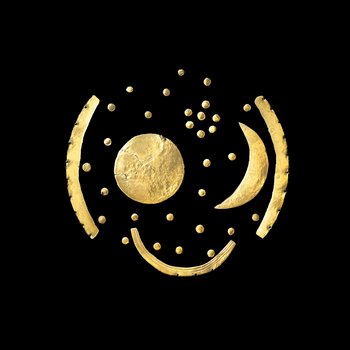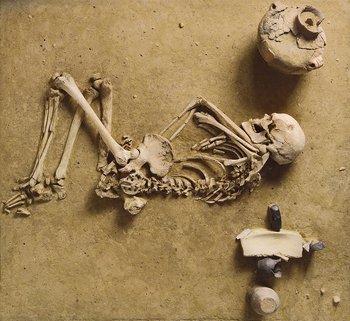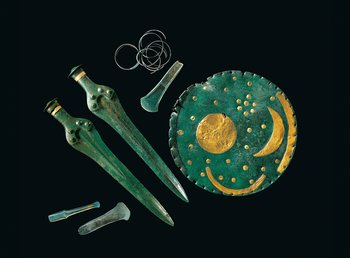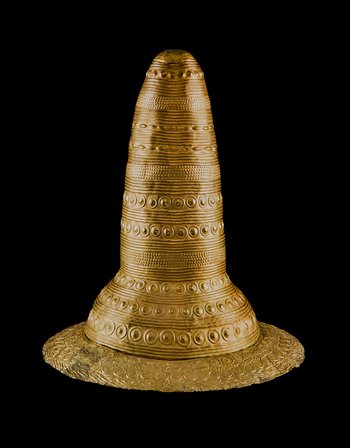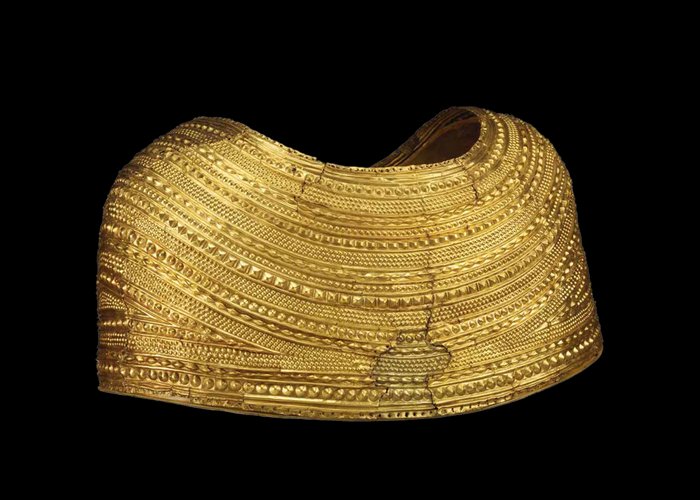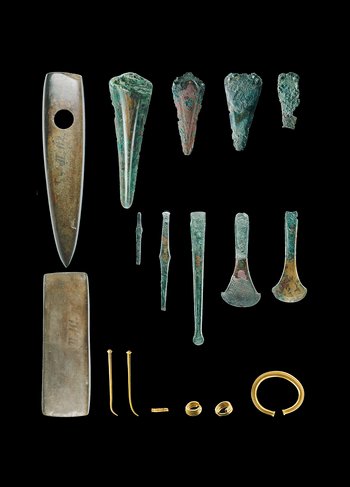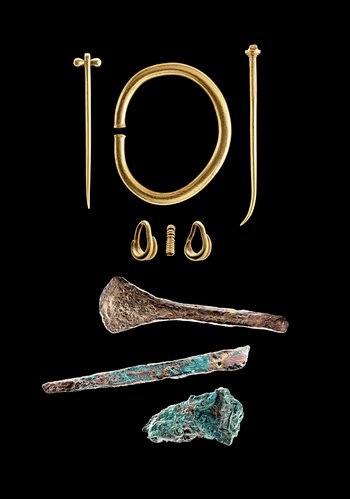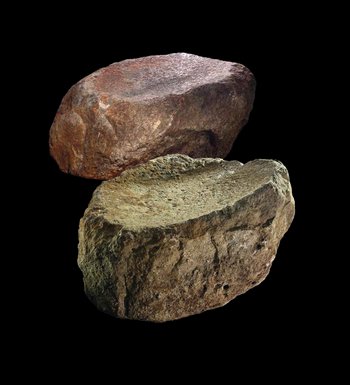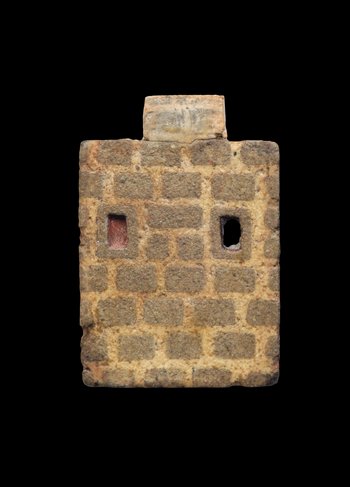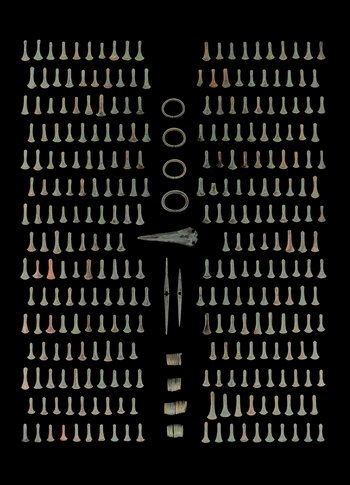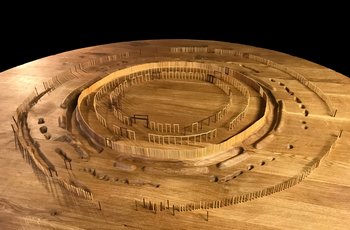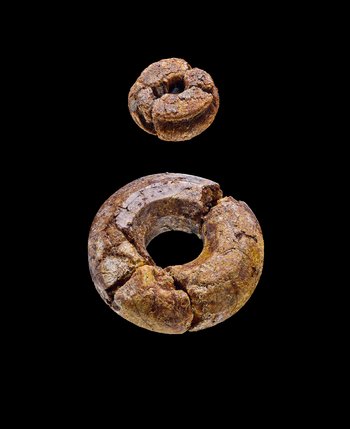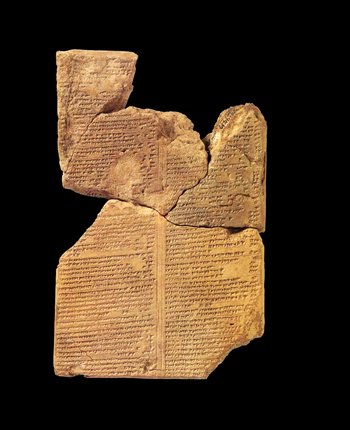Exhibitions archive
The World of the Nebra Sky Disc – New Horizons: audio tour
We offer you more than 400 exhibits on around 900 square metres in our state exhibition ›The World of the Nebra Sky Disc – New Horizons‹! From this rich display of outstanding finds of world renown, we have compiled a selection of the top 10 exhibition highlights for you. We present these to you both on site as an audio guide and online to help you prepare for and review your visit to the Landesmuseum.
We wish you an informative and entertaining audio tour!
Texts: Bernhard Steinmann
Editing: Christoph Hein/Fritz Oldemeier, Linon Medien
Welcome and introduction by Harald Meller
Welcome to the State Museum of Prehistory and our temporary exhibition ›The World of the Nebra Sky Disc – New Horizons‹! To start your tour, Professor Dr. Harald Meller, director of the museum, would like to give you a brief introduction to this fascinating exhibition.
»It was nearly twenty years ago when the Nebra Sky Disc first drew public attention – and in 2013, it was inscribed as UNESCO Memory of the World. Since then, we have been able to gain many new insights, not just into the Sky Disc itself and the objects buried with it, but also into the cultural context of that era – for instance, the Pömmelte Woodhenge or the monumental princes’ graves in today’s Saxony-Anhalt. Our exhibition offers you a chance to explore this knowledge. Yet it does more than that – after all, even if the region of Central Germany was once a cultural centre in the early Bronze Age, this development took place in a much wider frame. Finds from Mesopotamia in the far south-east, in Crete, Sicily, and Spain and – last but not least – to the north-west close to Stonehenge in England tell us just how closely the early Bronze Age people across Europe were networked – and those networks even reached into the Middle East. And now, enjoy exploring these many surprising and amazing connections in Bronze Age Europe!«
Wennungen block excavation: Corded Ware Culture
The skeleton of a man from the Neolithic period is lying crouched on its side. The grave, found at Wennungen, was excavated as an entire block. The deceased was buried with a pottery beaker and stone battle axe as grave goods. His skull bore traces of an injury from just such a battle axe, though that wound had healed. He belonged to the Corded Ware culture – a Neolithic cultural group named after their pottery vessels, which are imprinted with cord-like designs. The Corded Ware culture was found in Central and Eastern Europe from around 2800 BC until approximately 2200 BC. At that time, people lived in hamlet-like settlements. They often covered their graves with small burial mounds, making them visible monuments above the earth. Yet even without burial goods, Corded Ware graves can still be identified since the dead were always buried in the same position. The deceased are lying crouched on their side facing south, with the men’s heads pointing west and the women’s pointing east – as you can see in the woman’s grave from Wennungen directly adjacent. This woman was buried with a bag or sling set with dog’s teeth and containing the bones of an infant.
Menhirs, for instance, are other artefacts testifying to the Corded Ware Culture. These stone stele once stood upright and were engraved with drawings of weapons, clothes, jewellery, and facial features. The menhirs from Seehausen and Dingelstedt set up at the front of the gallery are exemplary for these ›standing stones‹, once common across much of Europe. They were also found in the Black Sea region – which, as genetic analysis has shown, was home to the ancestors of the bearers of the Corded Ware culture. Large numbers of Corded Ware peoples migrated from there to central Europe.
The Nebra hoard find
The Nebra Sky Disc is the oldest known concrete representation of the sky. It shows a crescent moon, a sun or a full moon, and around 30 stars, including the Pleiades star cluster. A fat crescent moon and the Pleiades as depicted here only appear in the night sky together every three years – a constellation indicating an additional month is needed to align the lunar and solar year. This alignment provides the basis for a reliable calendar – and anyone able to read this calendar was a powerful figure in the community, since they knew the times of the most important annual festivals.
The Sky Disc is thought to date from around 1750 BC. It was used for an estimated 150 years, though evidently its function changed several times. The two golden horizon arcs were first added during this period, though only one of them has survived. When the arcs were attached, three stars were either covered or moved slightly. The arcs show the rising and setting points of the sun over the year, and so also mark the times of the summer and winter solstice. There was another addition to the Sky Disc as well – a simplified arc-shaped representation of a boat, with oars engraved as short lines. This is the solar barge which carried the sun across the heavens every day.
The little punch holes in the perimeter of the disc were also a later addition. Evidently, the Sky Disc was fixed to a base of some kind so it could be shown publicly. From then on it was purely a symbol of power, and read in a fundamentally different way from its original meaning.
The Sky Disc was buried on the Mittelberg hill near Nebra in around 1600 BC. In the process, one of the horizon arcs was removed – possibly as a way of symbolically destroying the Sky Disc. Nonetheless, we know it was highly regarded to the end, since it was buried with other objects – two precious swords, two axes, a chisel and two spiral arm-rings. Such objects recall the kind of grave goods also buried with princes in the early Bronze Age.
Mold Cape and Schifferstadt Golden Hat
Pieces of clothing of pure gold testify to the Bronze Age’s riches and artisan skills. We would be very glad if we knew more about the precise context and use of such gold regalia. No doubt, they were only rarely worn and only by high-ranking figures with especially prominent roles in ceremonies – perhaps as a way of highlighting their close connection to the world of the gods.
The two treasures on show here are spectacular examples of such garments. The high conical hat with a brim was found near Schifferstadt in the Palatinate in southern Germany. It is one of four known artefacts of this kind. Thanks to the three axes buried with the hat, we can date it – to around 3400 years ago! This fragile object probably served as the headdress of a powerful figure, perhaps a priest or priestess.
The Mold Cape is even older and quite unique. The pattern looks like a series of overlaid chains. At the base you can see a series of tiny holes, indicating it was once attached to a lining, possibly made of leather. The cape was fitted over the head, and placed over the shoulders and upper body so it also covered the upper arms. During the ceremony, the person wearing it – most likely a woman – could only move slowly and carefully. The ceremony may well have followed a strict ritual. The cape was found in Wales in 1833. Gold fragments from a second cape were found in the same grave, together with the remains of a bronze dagger. At that time, the workmen who discovered the grave said there were also 200 to 300 amber beads. Today, only one single amber bead is known to have survived, the rest are thought to be lost.
The Leubingen and Helmsdorf princes’ graves
When the Leubingen burial mound was opened in 1877, archaeologists discovered one of the richest Early Bronze Age graves ever found in Central Europe. The earth covered a stone core with a burial chamber of oak beams in the shape of a hut. The grave was still extremely well preserved. The body of the dead man lay stretched out on the ground with his grave goods around him – gold ornaments, various weapons and tools, and ceramic vessels. Dendrochronological analysis of the wood’s tree-rings dates the burial to around 1942 BC.
Thirty years after the sensational discovery in Leubingen, a second burial mound of this kind was opened in Helmsdorf, roughly 70 kilometres to the north east. The burial chamber was almost identical with similarly extensive and well-preserved grave goods – gold ornaments, weapons, tools, and ceramics, just as in Leubingen. In Helmsdorf, though, there was also a wooden funeral bier – a unique find. The remnants of the wood date the chamber to 1829 or 1828 BC.
So the burial chambers at Helmsdorf and Leubingen not only had a similar structure, but also contained remarkably similar grave goods. The gold ornaments decorating the deceased were nearly identical, and followed the pattern of burial practices for high-ranking local rulers. Since such customs were transmitted down the generations, they also provide evidence of a continuity in power structures.
In comparison to other burials at this time, the Helmsdorf and Leubingen burials have one or two special features. First, the deceased lay on their back – contrary to the custom of burying the dead on the side in a crouching position. The grave goods included an old splitting wedge and a stone axe – items quite possibly thought to be massive axes belonging to mythical ancestors. The chisel and whetstone found in Leubingen point to metalworker skills. Yet such a ›princely‹ ruler was unlikely to use such tools personally. Instead, as in the previous Bell Beaker culture, they may well have invoked the high status of metalworkers. In contrast, the burial mounds themselves, unusual among Early Bronze Age peoples, suggest a reference to the Corded Ware culture.
Hence, many aspects of the Leubingen and Helmsdorf burials refer to the ancestors, consciously preserving elements of the preceding Bell Beaker and Corded Ware cultures whose peoples, as we know from genetic analysis, were connected to the Early Bronze Age Únětice culture. So these two ›princely‹ graves also express that process of peaceful cultural assimilation.
The Bornhöck grindstones
The model shows you a reconstruction of the Bornhöck burial mound near Raßnitz. This was the largest known Únětice culture burial mound. In the nineteenth century, though, it was removed during a land consolidation programme. Just a few years ago, its remains were newly excavated. As you can see from the model, the mound held a tent-like wooden burial chamber under stone packing covered by earth. Some of the stones are displayed here – and surprisingly, they are fragments of unusually large grindstones. Most of the stone packing has been lost, but estimates put the original amount as equivalent to 550 to 600 grindstones. This is a vast number, given that grindstones were complex to produce in the Early Bronze Age. They would have been too valuable to have been simply used as packing material.
With grindstones of this size, the top handstone would have been so large and heavy it needed two people to push it across the stationary base or quern stone – back-breaking work possibly carried out in centralised workshops and involving slavery. In particular, the number of grindstones suggests a production of flour far exceeding the needs of one household or a small community. Instead, this points to the systematic production of flour and a centrally organised distribution of goods – as in the early states of the eastern Mediterranean basin or Mesopotamia. Since ground flour soon spoilt, it had to be processed immediately. This amount of flour might have directly fed entire population groups or been used to bake a large number of loafs for ceremonial purposes. It was unlikely to be for a village settlement, since people there could provide for themselves from their farming. Instead, the flour may have been destined for specialised craft workers, for administrators, or for the soldiers in an army. Ultimately, these grindstones suggest the Únětice society in Central Germany was significantly more complex than previously imagined, with structures most likely similar to an early state.
Early state formation in the Únětice Culture?
The finds from the early Minoan civilisation on Crete provide evidence for state structures – even if we cannot yet decode the system of writing and know relatively little about their social elites. The Minoans had towns with large communal buildings, an administration with written documents and a system of seals, an infrastructure with farms, streets and large warehouses, and a barter system which was largely centrally organised.
But what is actually a state? Today, the state is a familiar institution – yet a state is not an inevitable development and requires a basic set of conditions to exist. The renowned German sociologist Max Weber defined the state as a political organisation by which a human community lives in a given territory under an established power claiming a monopoly on the legitimated use of physical force.
Certainly, we can find these elements in the Únětice culture in Central Germany as well. Here 4000 years ago, there were also symbols of power such as the gold axe of Dieskau or the magnificent ornaments of the Leubingen und Helmsdorf princes, regalia which remained the same over the generations. Those rulers could control and enforce their power through a well organised army – whose existence can be reconstructed from the evidence of the bronze hoards. The large grindstones found at Bornhöck suggest the centrally organised production of large amounts of flour which could then have supplied particular groups of the population such as the army. In contrast to the Minoan villas or palaces, no Únětice towns or other large communal institutions have yet been found, and so this early state would have depended on the authority and charisma of its leader.
The Dieskau III hoard
The region around Dieskau is notable for the density of finds of Early Bronze Age hoards, including the largest Early Bronze Age hoard ever found in Europe. A ›hoard‹ is a term for individual objects or a collection of objects deliberately buried in the ground by the people of that time. Such finds are not connected to a burial, and are often read as sacrifices to the gods or as things hidden at a time of crisis. Some hoards may even have just been buried, as it were, for the proverbial rainy day. But the composition of the hoard on show here tell us a lot more.
The Dieskau III hoard, for instance, contains 293 axes, bronze rings, bracelets, two double axes, a halberd and other bronze remains. With a total weight of 45 kilos, this is the largest hoard ever found in Central Germany. A look at the weapons and their material is especially instructive. 178 axes are made of copper, 100 of arsenic bronze, 10 of antimony bronze and only one each of nickel bronze and lower quality tin bronze. The axes are more or less bright reddish in colour, while the double axes have a silvery sheen. These contrast sharply with the gleaming gold of the leaders’ and princes’ high-tin bronze weapons found in the graves.
This classification is similar to all major hoard finds, showing that the axes were also buried in set proportions. The numbers in the particular hoards suggest a military system of units of 15, 30, 45, 60, 90, 120 and 300 soldiers led by officers equipped with specific weapons.
Circular sacred sites
No doubt Stonehenge is Europe’s most renowned circular sacred site. Yet you can find similar circular sanctuaries surrounded by graves and low ramparts on the European mainland – not least in the Middle Elbe and Saale region. Usually, though, the circular structures were not shaped by standing stones as at Stonehenge. Instead, as on this model of the Pömmelte circular sanctuary near Magdeburg, they were ringed by wooden palisades. Since wood decays, most sanctuaries of this type have not survived.
Such circular sanctuaries were built particularly in the Neolithic period – that is, between 5500 and 2200 BC. These sacred sites are aligned with the movement of the sun. For instance, sanctuaries such as Goseck from the fifth millennium BC have clear points of reference to the summer and winter solstice. In contrast, Pömmelte appears to be aligned with quarterly festivals. In that sense, the structures were also important in dividing the year and, above all, setting the dates of recurring festivals. They could also have served as assembly places for the community and places of refuge when attacked.
The circular sanctuary at Pömmelte was constructed in the third millennium BC at the time of the Bell Beaker culture. But it was erected at a place which had already been a cult and burial site for the Corded Ware peoples. When the Pömmelte sanctuary was built, the remains of a burial mound and a small rectangular enclosure would certainly have still been visible, and they are referenced in the cult site’s design. Traces of ritual practices were found in sacrificial pits containing shards of ceramic vessels, animal bones and grindstones. The more macabre finds included human skeletal remains of women and children. These were not buried in the usual manner, but thrown into the pits. In some cases, they show signs of severe head and rib injuries or have body parts missing. It is no longer possible to say whether these remains result from armed conflict or rituals involving human sacrifices.
Amber
These two small amber beads were found in Mesopotamia, yet the raw material came from the shores of the Baltic Sea. Without doubt, amber is one of the most fascinating windows on long-distance trade in the Bronze Age. Amber is fossilised tree resin from forests growing in Europe millions of years ago. In particular, large amounts of amber washed up on the Baltic coast. Amber has been collected there for thousands of years and, quite possibly, its characteristics have been admired for just as long – since, for instance, it floats in salt water, is flammable, and if rubbed becomes electrically charged. These reddish-orange stones may well have been attributed special powers as well. Baltic amber also has a particular role in archaeology. Since its chemical structure is different from other types of amber, it can provide crucial evidence in tracing long distance trade routes. Amber was traded across large areas of Europe – as a raw material, for instance, transported from the Baltic to southern England. There, it was shaped into decorative beads set in gold foil – and such beads have been found as far away as Switzerland, and even on Crete. But along with the southern English Wessex culture, the Únětice peoples in Central Germany and Bohemia evidently also controlled the Baltic amber trade, allowing little of it through to areas further south. In the Mediterranean region, Baltic amber was exceptionally rare – and has only been found in the richest Mycenaean civilisation graves in Greece. Interestingly, some graves not only contained chain jewellery which can best be compared with pieces from southern England, but also amber beads from Bohemia in the form of an eight. Even less amber was traded further east – to Egypt or the Middle East. There too, amber is similarly only found among the possessions of the ruling elites. The ring-shaped amber beads from Mesopotamia mentioned earlier are superb. In Mesopotamia, amber was an incredibly rare precious object. As such, it was not just ideal to consecrate to a deity but, at the same time, illustrated the ruler’s power to obtain treasures from the ends of the known world.
MUL.APIN tablet and intercalary month
These fragmented tablets in cuneiform script belong to the Mesopotamian MUL.ALPIN tablets which record the rising of the constellations over the course of the year. The tablets contain part of the astronomical knowledge collected and preserved over millennia. Of course, to establish a calendar, the moon is also a point of reference. However, a purely lunar calendar needs an additional month every three years to align the solar year and the seasons. So only a lunisolar calendar, combining the movement of the moon and the sun, first made it possible to determine the precise dates of recurring religious festivals, or sowing and harvesting times, and also set a day for collecting taxes. In this way, a calendar became a formative element in a society – and, not least, an instrument of power.
The Nebra Sky Disc depicts the same phenomenon as described on the tablet. If the four-day-old crescent moon appears next to the constellation of the Pleiades then an intercalary month is necessary to ensure the calendar remains accurate.
The Nebra Sky Disc shows that the astronomical knowledge originally developed in Mesopotamia and Egypt was also present in Central Europe. Most likely, it was brought here by travellers covering vast distances along the widely branching trade routes. The presence of a lunisolar calendar in Central Europe’s Early Bronze Age not only evidences such a knowledge transfer, but also shows how Bronze Age societies in Central Europe were far more developed than previously thought.
